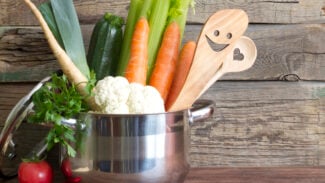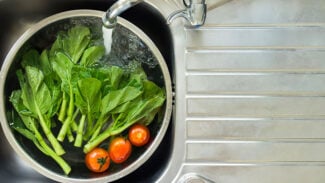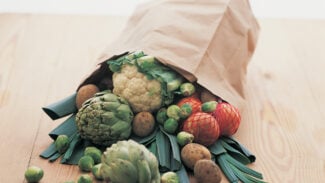Hiya Sweet Friend,
Check out this super informative guest article by Jennifer Reilly RD, LD, from my blog archives. Happy reading—take it away Jennifer!
xo, Kris
As a dietitian and cheerleader for all green and life-extending foods, there’s one food I absolutely can’t wrap my fork around: raw broccoli. I eat kale right from the stalk and down wheatgrass shots with an ear-to-ear smile. But when it comes to broccoli, it’s got to be steamed, roasted or sautéed. So the question arises, am I killing my broccoli, and is it even worth it if I can’t juice or chomp it in its raw form? What actually happens during the cooking process, and are foods better raw or cooked?
Cooking does have advantages. It reduces or kills toxins that would otherwise be problematic in our systems. For example, the toxicity of aflatoxins found in peanuts is reduced by 45 to 70 percent when they’re roasted (note that they never go away completely). Kidney beans and soybeans can’t be sprouted because they’re toxic raw. Cooked and chilled, however, these beans make a charming salad.
Cooking improves the digestibility of some veggies and legumes and, therefore, increases the wealth of healthy chow we can enjoy. The availability of sulfur-containing amino acids is increased in cooked soybeans. Cooked potatoes are easier to digest, taste better and are still full of plenty of cancer-fighting vitamin C. And thanks to cooking, we can easily benefit from an eggplant’s potent cancer-fighting antioxidants nasunin and chlorogenic acid, which not only scavenge free radicals and protect cell membranes from damage, but also aid in reducing “bad“ LDL cholesterol. Eggplant isn’t toxic in its raw form, it’s just incredibly fibrous and fairly challenging to eat.
Heat actually boosts the levels of beta-carotene and lycopene available in fruits and vegetables by breaking down cell walls and increasing the body’s ability to access the nutrients bound to the walls. Beta-carotene is converted to vitamin A in the body and is found in orange, yellow, red and green leafy vegetables. It plays a role in the prevention of cancer and heart disease, helps your immune system, reduces high blood pressure, and can even protect your skin against sunburn. Lycopene, which gives tomatoes, watermelon, pink grapefruit and apricots their red color, is increased two and a half times in cooked foods. Lycopene is best known for its role in prostate cancer prevention, but it’s also helpful in reducing “bad” LDL cholesterol (just like eggplant … veggie ratatouille anyone?), and preventing osteoporosis, skin cancer and even breast cancer.
On the downside, cooking does have certain disadvantages. Water-soluble vitamin C is highly unstable and is easily oxidized, destroyed by heat and dissolves in cooking water. This is why vitamin C levels drop by about 10 percent after two minutes of cooking.
Cooking also destroys digestive enzymes, which may be essential for optimal health. While we naturally make gobs of digestive enzymes, it can only help to get a few spares in the foods we eat. For example, when it comes to broccoli, raw is actually better than cooked (Nooo!) since heat damages myrosinase – an enzyme necessary for the production of sulforaphane, a precancerous cell ninja destroyer. And while heat may increase the beta-carotene availability in carrots, it also destroys their polyphenols, which are strong antioxidants that reduce the risk of heart disease and cancer.
Looking to lose weight or maintain a healthy weight? Raw fruits and vegetables tend to be more advantageous when it comes to healthy weight control since they contain fewer digestible calories per pound than cooked veggies, and may increase your resting metabolism.
The verdict? A mix of raw and cooked foods is ideal. Some experts recommend at least one pound of each per day. Juice veggies that you may not enjoy raw so you can get the benefit of their life-giving and fully intact digestive enzymes and nutrient powerhouses. Mildly steam or sauté certain veggies from time to time to make them more palatable and richer in antioxidants like beta-carotene and lycopene. Avoid lengthy cooking times, heavy frying or deep-frying, and excessive boiling, which drastically decrease the vitamin C content of foods, and produces unsexy free radicals in the case of frying and deep-frying. And finally, shred that raw broccoli and add it to green salads and wrap sandwiches. It’s not so bad!









Very good article Jennifer! I agree that people should go half and half with their raw and cooked veggies. You had some great specifics on the individual vitamins, minerals, and phytonutrients that are either increased or decreased during the cooking process. I’d love to see all the references for this info. I’m an academic geek like that 🙂 But all the info was very much in line with an article I wrote on raw vs. cooked foods
Thanks for the great info!
Just marinate the broccoli in oil, spices and anything else you like, and it becomes soft and flavorful.
Raw broccoli soup is also delicious.
Dehydrator for a bit!
As a two time cancer survivor, I am soooooooo enjoying your book and am inspired to eat well!
Thank you for of the research and for giving us knowledge we’d never get at the oncologists office!
raw broccoli is actually good in slaw — a combination of cabbages, carrots and broccoli — with a healthy dressing and sprinkled with sunflower seeds is a great salad! i use some cilantro in it sometimes, and always plenty of seasonings — like garlic, pepper…other herbs sometimes — make it ahead and it’s great as a side dish — or a lunch…
Thanks for sharing! I try to eat half and half. There are some veggies that do digest better for me when I lightly steam them. Good tip about juicing vegetables that we don’t like as much. 🙂
Take care,
Evelyn
I always love your posts, thanks!
Jodi
These are some great ideas for getting your broccoli raw. However, I have recently learned that eating your brassicas raw (broccoli, cabbage, cauliflower, kale) only raw can inhibit the conversion of T4 to T3 thyroid. That can lead to hypothyroidism. So I agree, mix it up. Some raw, some cooked. A balance is always good.
Great ideas, Dimond!
And great ideas, Molly! Thanks!
My regular greenylicious morningsmoothie
zuccini
orange
avocado
broccoli
various superfoods
vanilla
cinnamon
Awesome way to start the day green!
Love & Bliss
elenore
Juice it! Two apples, 1 pear, 2 broccoli florets and then blend it all with two kiwis. Recipe from innocent juices based in the UK. It’s delish
I just made a raw salad with broccoli and cabbage. Secret ingredient….marula vinegar- delicious!
Wtf where doese it say if broccoli is better cooked or uncooked? (in that whole friggen chapter) -_-